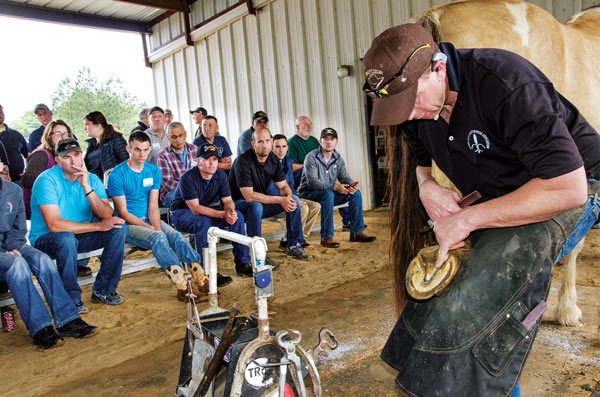Pictured Above: It's critical to seek continuing education opportunities. Attending clinics and conferences not only will expand your knowledge, they offer a chance to network with other farriers.
Attrition rate is a business management term that’s used to describe the loss of business, product or employees. Companies do not want to see a high attrition rate.
When there’s a high attrition rate, it means there are mistakes happening in the company’s production of the product and the customer satisfaction is not being met, and/or the morale of the employees is low and they are seeking jobs elsewhere. A critical and constructive analysis is needed to seek out the reasons for the loss of business and employees.
Unfortunately, there’s inevitably a high attrition rate in the hoof-care industry, not only with clients coming and going from your books, but also new hoof-care professionals not getting their business off to a solid start and deciding it’s not for them.
As a hoof-care professional, you are managing client satisfaction, the unpredictable nature of the horse, as well as managing your own morale and job satisfaction.
To help navigate you through this, here are five common mistakes that I have found inhibit business growth as hoof-care professionals and lead to high attrition rates, as well as keys to avoid making them.
1
Lack Of Communication
Clear communication is key to maintaining low attrition rates. Part of clear communication is setting boundaries for what your business relationship will be between you and your clients.
Define what you expect from your clients in your practice. For example, informing potential clients that you only work on well-behaved horses, you require shade and shelter from the elements and payment is due at the time of service.
Clear lines of communication will ensure that you and your clients understand what’s expected in your business relationship.
Use a critical eye before using the newest approach or product in hoof care. Being able to stand behind your work leads to a long and fruitful career.
Recognizing when you’re in over your head will save you from a bad reputation. Calling in a mentor to help will be a great learning opportunity for you.
It’s also important that you make sure your client knows what to expect from your services. If there are expectations that you know you cannot meet, make sure to let the client know. If you fail to communicate boundaries and expectations, it will lead to one or both parties being unsatisfied with the hoof-care professional/client relationship.
One of the most common reasons that clients look for a new farrier is because, “my old farrier/trimmer did not return my phone call. They just dropped off the face of the Earth!”
Even if your schedule is booked solid, make it a priority to listen to voice mails and return calls before the day is over. This is a simple way to ensure you’re not missing out on potential clients or losing established clients. It’s easy to get busy during the day and lose track of time. However, with today’s technology, all it takes is a few seconds to send a text. Even if it’s a quick, “Got your message, I will call you back before the end of the day.” Clients appreciate you taking the time to let them know they are important to you.
Not showing up or being very late for an appointment is also a form of communication breakdown. There’s really no excuse for this. A quick text message or phone call letting your client know your estimated time of arrival is good practice. Good communication is one key way to keep clients on the books and yet is often neglected. This results in it being one of the top reasons clients shop around for another hoof-care provider.
2
Not Keeping Your Cool With Fluffy
It’s the end of a hot summer day, last horse, last hoof. Fluffy decides you’ve had his hoof up long enough and takes it out of your lap. You have two thoughts that run through your brain.
- Stand up and assume the position for a good kick in the belly.
- Deep breath, it was probably a fly or old Fluffy is feeling his age and arthritis was flaring up.
Remember, your clients view Fluffy as a loved family member. They often will judge you and your work by how you interact with Fluffy. Take the time to develop your horsemanship skills. Learn the difference between a fight or flight response. Communicate with your client about how Fluffy is making your job quite difficult. Come up with an action plan based on the following questions:
- How can we help Fluffy become more confident while handling his feet?
- Do we need the vet out for some help with sedation?
- Is this an attitude problem that the client or trainer needs to address?
Do not take matters into your own hands in an attempt to solve the problem. This can get you hurt — professionally and physically.
How you hold a horse’s hoof/leg communicates a lot to the horse. Do you ask and wait for the horse to lift its hoof for you or do you grab hold and jerk it up? You do not want to be known as an impatient farrier. Being kind to the horse will show your client you care and respect their horse.
3
Practicing “Risky” Hoof Care
Practicing fundamentally safe hoof care will ensure you do not take unnecessary risks. Your clients, owners and horses will thank you for it.
There are many different and “new” techniques for treating various hoof conditions. When you are approached about trying something new, remember horse anatomy and how the structures function. Ask yourself some key questions:
- Does this technique or device have the potential to cause damage?
- Does this classify as risky?
- Will I be able to stand behind my work?
Do not be led blindly into believing the newest approach or product is good and sound. Do I need any special training on the application of the technique and/or device? Put them through a series of tests to decide for yourself whether it will benefit the horse and accomplish what’s intended.
Nowadays, Google is everyone’s go-to for immediate advice. Unfortunately, this can lead to conversations about the latest device that your client read about. They ask you for your opinion and now you have a dilemma. You might lose this client if you disagree with the technique or device your client is asking you to use. “If you do not put it on, I’ll find someone who will.”
If you decide to try the questionable technique or device on Fluffy, you have two possible outcomes. One, it works and you are the hero for today. Two, it does not have the intended effects and Fluffy’s condition worsens. You most likely lost a client, as well as the respect of your peers who follow behind your work.
4
Not Knowing When To Say, “I Don’t Know”
Our previous mistake can lead into this one. Early on in your career as a hoof-care professional, you will encounter cases that you have read about, but have never had hands-on experience with. You have two options: Try to remember everything you read on the case and fly solo or realize you may be in over your head and call in a mentor to help out.
This is a great opportunity for growth as a person and professional. If you choose the first option, you will either succeed and be the hero for the day or you might fail and have to eat humble pie. The wise choice would be to call in a mentor to help out on the case. Fortunately, the main reason we came into the hoof-care industry was the good of the horse. Most hoof-care professionals with years under their belts will jump at the chance to help a new person to the trade. Most clients will appreciate your humbleness and eagerness to learn when you call in help.
5
Not Seeking Growth Opportunities
Continuing education isn’t required in the United States and Canada. Yet, simply because it’s not required doesn’t mean you should avoid it.
Once you develop a steady source of income and consistent clients, it’s easy to get into a routine and not seek opportunities for growth. Looking at a trim and saying, “It’s good enough,” is a dangerous road to travel. We should be constantly seeking to improve our work. When we do not seek improvement, burnout is a real possibility. When thoughts of “it’s just a trim, it’s good enough” are common, we need to re-evaluate what we are doing.
In the hoof-care profession, there’s always something to learn and ways to improve. The more you learn, the more you realize how much you do not know. There are countless free clinics around the country — you just have to get there. The individuals who attend clinics are also seeking to grow their craft. Take advantage of the opportunity to develop relationships with the clinic attendees. They can become your source of encouragement, knowledge and friendship.
Use the internet for your benefit. American Farriers Journal has a bountiful online library full of videos and articles that will help your education. Webinars are popular and are recorded for reference if you can’t attend it live.
Don’t forget about the trusty book! Keeping up-to-date on the trends and products will keep you prepared for questions from your clients. We all learn differently and at different rates. Use all the tools available to further your education.
Look carefully at each foot you work on and find the ways you can improve. This will keep your brain engaged and keep you thinking positively. Your clients will notice your desire for improvement. They will respect you and also encourage your growth. They love to know you’re learning more to help Fluffy.
We all have bad days when we make a mistake or two or three. Don’t dwell on them. Learn from them and move on. Avoiding these five common mistakes will jump start your business. The root of lowering your attrition rate is to provide superior service to your clients, to communicate, to continue your education and to never forget the ultimate reason we are all in this profession — for the good of the horse.









Post a comment
Report Abusive Comment